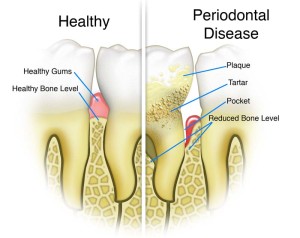What is Periodontal Disease?
Our mouths are full of bacteria. The white/pale yellow plaque layer that appears on the teeth contains a massive amount of these bacteria. The formation of dental plaque is a normal process and cannot be prevented; however it is important to remove it daily. Failure to remove dental plaque can lead to dental caries, tartar formation and periodontal disease. The longer plaque and tarter remain on the teeth the more harmful they become. They cause the gums to become red, swollen and bleed easily, a mild form of gum disease called gingivitis. Gingivitis can be cured with regular dental appointments and good home care. Left untreated Gingivitis will advance to periodontitis. As the disease advances it results in the destruction of the adjacent periodontal ligaments and supporting bone. Once you have it, you cannot be “cured” of it. The best that can be done is to “maintain” it through continuous periodontal therapy and good home hygiene habits.
What are the Signs and Symptoms?
Gingival inflammation and bone destruction are often painless. Periodontitis progresses relatively slowly in most people.
- Redness or bleeding of gums
- Gum swelling that recurs
- Bad breath, and a persistent metallic taste in the mouth
- Gingival recession, resulting in apparent lengthening of teeth.
- Deep pockets between the teeth and the gums
- Loose teeth
The Perio-Systemic Connection
Several research studies have suggested that periodontal disease is connected to variety of other diseases, including heart disease, diabetes, and rheumatoid arthritis.
Risk Factors
Contributing systemic risk factors may affect treatment and therapeutic outcomes. These may include: diabetes, smoking, certain periodontal bacteria, aging, gender, genetic predisposition, systemic diseases and conditions (immunosuppression), stress, nutrition, pregnancy, HIV infection, substance abuse, and medications. Elimination, alteration, or control of risk factors which may contribute to chronic periodontitis should be attempted.
Treating Periodontal Disease
The goals of periodontal therapy are to alter or eliminate the microbial etiology and contributing risk factors for periodontitis. This is done by removal of the calculus (tartar) and smoothing the tooth and its root surfaces, a procedure called Scaling and Root Planning. These procedures do not involve surgery and are done in one-quarter to one-half of the mouth at a time. Once the disease progression is arrested a lifetime of continued periodontal maintenance is required to prevent the recurrence of periodontitis. As previously mentioned once you have periodontitis, you cannot be “cured” of it, the best that can be done is to “maintain” it through continuous periodontal therapy and good home hygiene habits.

